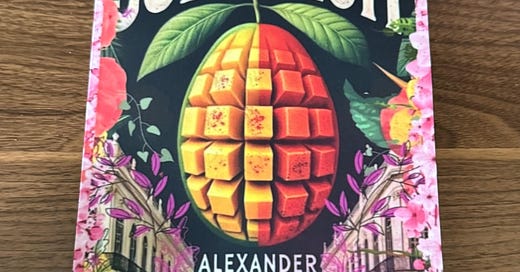This is part of Substack Summer for Summer 2025. You can read more about Substack Summer here.
Substack Summer Overview
Welcome to the first of my “reviews” (?) for Substack Summer ‘25. Since this is the first one, let me walk through how I’m planning to set these up. Posts will be broken down into a few sections:
Just the Facts - all the basic info about the book/novel/story
Pump the Tires1 - this is my bias disclaimer where I lay out what relationship I have, if any, with the Substack writer whose work I’m discussing. It works on a 1-4 scale; 1 being I barely know this person and 4 being you cannot trust a word I say.
Overview - this is my “review” of the work in question, including any:
Stick-taps - positive aspects I really enjoyed
Chirps - anything about the work that didn’t work for me
Overtime - miscellaneous thoughts and an update on the overall progress of the Substack Summer project.
Just the Facts
Title: Cubafruit
Author:
Format: eBook. Paperback. (Read via both formats)
Genre: Thriller
Substack: big reader, bad grades
Length: 425 e-pages. 524 paper-pages.
Vinny’s Blurb: A cinematic political thriller with dashes of magic realism and gallons of blood that explores geo-political violence from the ground up. Propulsive and engaging storytelling, dripping with deeper meaning, Sorondo weaves a spider’s web of intrigue that lures you in and holds you there.
Pump the Tires
🫥🙂😀⚫ 3/4
I found Alex’s work through
and his profile of William T. Vollmann. I also enjoyed his write-up on Cormac McCarthy’s last work and have been a frequent reader and a subscriber to his ‘Stack, so I went into Cubafruit with high hopes. I’m a fan of Alex’s work and we message with some frequency on whatever Substack calls its version of Twitter. He also compared my writing to Nick Hornby and I am nothing if not susceptible to flattery. For those reasons, I give myself a 3/4 on the potential bias scale.Overview
Confession: I judged the book by its cover and assumed “cubafruit” was a term for mango I hadn’t heard before. It didn’t take long for my book to be littered with little “what the fuck is cubafruit?!” marginalia. The mystery of the cubafruit makes a nice analogy for the rest of Cubafruit: nothing is quite what it seems.
Cubafruit is a thriller, but it’s a maximalist thriller which almost sounds like an oxymoron. Depictions of violence and dismemberment drift into splatterpunk, while the cast of characters seems to grow page-by-page, (almost) all of them figuring in the climax. It doesn’t follow the usual man-with-a-gun trajectory of most thrillers. The novel is political, weaving in the machinations of a Machiavellian "rebel,” the pragmatic terrorism of real rebels, and the ineffectual posturing of a left-leaning administration. Throw in some US meddling and gang violence, and sprinkle with narcotic fruit, vampiric fish, and foreshadowing coyotes.
This is all before we get to the “literary” aspects of the novel. Alex wrote recently about Millennial Substack novels focusing on failed or failing institutions and who gets to provide the narrative of their decline and fall; “embattled by rhetoric” to use his phraseology. I haven’t read the other novels mentioned (yet), but my interpretation of Cubafruit fell along the lines of: no matter how complex the narrative, the truth is impossible to bury. Rhetoric is a building on shaky foundation, waiting to crumble. And — without spoiling the book — justice/catharsis/conclusion doesn’t come in the form of rhetoric for Cubafruit, but in the violence it wrought from the beginning. Violence is, after all, an irrepressible form of “truth.”
Stick-taps
There is a scene (I won’t spoil) early in the story where a character emerges from an unexpected location and it really kicks the story off. The description has this duality of comedy and horror that I fucking loved. At that point, I let
JesusAlex take the wheel and strapped in for the ride.Sorondo’s narrative does this trick where he focuses tight on a specific character and slowly pans out to show their position on the larger chessboard of the novel, and it was so effective for me. He then subverts this later on by obfuscating how some characters fit into the overall story before a well-earned reveal.
This cast of characters is awesome. I feel like every chapter I’d have a new favorite character. And that character would get offed by my new favorite character. I would love to see what Sorondo could do with a quieter, more introspective narrative because his grasp of character is excellent.
The use of symbols and repetition is aces. Wolfdogs, Cubafruit, spiders, “full-auto,” the color purple. Narratives and stories. Stories as power.
Some killer lines:
“Scarred by piss and the chemicals to clean the piss bot now just dirt-smeared block”
“…like the dancing hair of wighted corpses falling, falling.”
“…a snack, a pistol with one bullet.” ((Killer!))
“The light is cozy jaundice.”
“… kneecaps like maracas.” ((I felt this one personally))
Chirps
Sorondo uses a lot of narrative stylings and tricks: Fourth-wall breaking. Staccato sentences. A lot of similes, metaphors and symbols. I mentioned before, this is definitely a maximalist novel. Most of these tricks work, but the use of the second person kept breaking me out of the story. It does add to the sense that this is a wild, barroom story that’s unfolding frenetically. There’s also a sense of the narrator unraveling a bit as the story starts to spiral out of control. It’s an interesting touch and an interesting decision to make the historical parts more “voice-y” than the present (day/tense) parts. That’s the gamble with maximalism: there were things I liked and things I didn’t. Obviously, your mileage may vary.
There are parts of the story that could be tighter. There’s an early chapter explaining an indigenous fish that is stylized almost like a food blog entry. It’s well written, and the fish is a symbol that recurs in the story (it’s a fantastic, parasitic symbol), but I think it might’ve worked better as a condescending monologue or a sermon or something that leaned more into the dichotomy beauty and danger, parasite and host. Which is not to say that Cubafruit is slow or bloated by any means.
The Kindle version I read had a noticeable number of typos. I don’t want to harp on this too much, but Sorondo’s writing is incredibly propulsive in places and to have a comma land in the middle of a word just ejects you from the story. It’s never to the point of illegibility, but since there is so much verbal trickery used as a narrative tool, that any of it might be a typo instead of intentional lingered in my mind. But that’s a minor quibble.
Overtime
The mark of a great book is that it is hard to put down. As someone whose brain has been addled by the advent of the Internet, I often skip ahead to see how long a chapter is before I embark on it. I did not do that with Cubafruit. I read past my allowed time- or page-count multiple times because the story hooked me. This proved very useful in finishing this larger book in relatively quick time.
My brain keeps jumping to film to make analogies for Cubafruit because it is so propulsive and cinematic. I said above it reminds me of a barroom yarn as told by someone who is getting progressively more animated (and possibly drunk) as the story approaches climax. The depictions of violence also have an over-the-top, almost anime-type quality to them. But this all functions like a Trojan horse for what Sorondo is getting at thematically.
Overall, a blast of a story. Pavel Bender forever.
If you are unfamiliar with this phrase, watch the first ten seconds on this video.
Pavel Bender gave me serious Sam Rockwell-on-a-cocaine-binge vibes. My man.
Jose Luis Verdano, who gets introduced via a chapter titled “Coupla Reasons to Worry About Jose Luis Verdano.”





